 |
|

|
 |
TABLE of CONTENTS
 |
MnDOT remembers fallen workers at Worker Memorial Day observances |
By J.P. Gillach
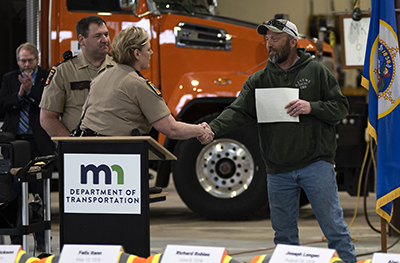
Nate Lamont, transportation generalist at the Mapleton truck station, was presented with Minnesota State Patrolís ĎSaved by the Beltí award during District 7ís Worker Memorial Day ceremony April 27 in Mankato. Nate was wearing his seatbelt when his MnDOT truck and crash attenuator was struck by a semi June 29, 2022, on I-90. Photo by Rich Kemp |
On April 27 and 28, MnDOT observed Worker Memorial Day in each of the eight districts throughout the state. The annual event honors and remembers fallen workers who died working on MnDOT construction and maintenance projects.
Since 1960, 35 MnDOT workers and 16 contractors have died while working on Minnesota highways. Gov. Tim Walz proclaimed April 28 as Worker Memorial Day and the Interstate 35-W bridge in Minneapolis was lit orange.
Hundreds of employees in every MnDOT district took time to remember and honor those workers in different ways, reflect on the current work they do and consider how to work safely.
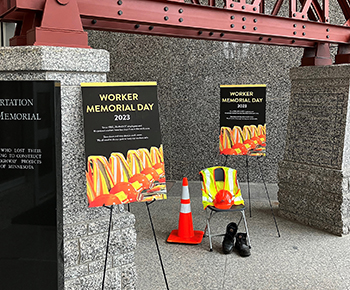
For Worker Memorial Day Central Office set up an empty chair display next to the Worker Memorial monument. Photo by Jackie Brown |
Events included district-wide memorials on Teams, in-person commemoration events, moments of silence, memorial displays at different
locations including lighted changeable message boards or other signs along with barrels, plus statements and media interviews about the importance of the day to MnDOT workers.
Central Office issued a statewide news release, created social media posts for MnDOT’s statewide social media accounts, and set up an empty chair display next to the Worker Memorial monument located at the main entrance to the Transportation Building’s lobby.
You can view the 2023 Governor’s Proclamation for WMD and the names of all the fallen workers included with the Transportation Worker Memorial on MnDOT’s Transportation Worker Memorial website.
|
| |
|

|
 |
TABLE of CONTENTS
 |
Hwy 52 project in District 6 enters final year of construction |
By Mike Dougherty, District 6 communications and public engagement
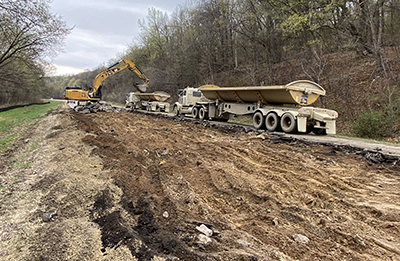
Crews worked on pavement removal on Hwy 52 southbound in mid-April along Wagner Hill south of Cannon Falls. Photo by Mike Dougherty |
Mile by mile, MnDOT crews are peeling up and carrying away layers of old pavement dating back to the early days of Hwy 52 between Zumbrota and Cannon Falls. The work is part of the final year of a $69.7 million project to reconstruct 13.5 miles of the southbound lanes along this high-volume route between the Twin Cities and Rochester. Construction began in July 2021 and is expected to be completed in November 2023.
This year, along with the paving work, Mathiowetz Construction will be replacing a bridge, constructing new snow fences and erecting a noise wall at Zumbrota. A new interchange was built in 2022 at Hwy 57, three bridges have been replaced in previous years (two at Hwy 60 east and one at Hwy 60 west) and about 6 miles of pavement was reconstructed in 2022. The southbound bridge at Hwy 57 received an Associated General Contractors award.
The project also includes closing 20 access points to Hwy 52 – a combination of driveways as well as township and county roads – which will continue the effort to turn the highway into a controlled-access freeway in the future.
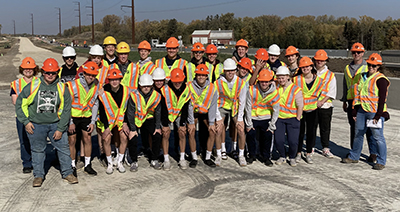
Students from nearby Zumbrota-Mazeppa High School visited the new Hwy 52-Hwy 57 interchange in October 2022 to learn about the science behind bridges. Photo by Mike Dougherty |
The interchange at Hwy 57 and Goodhue Cty Rd 8 is a key element in the project and received the most focus from residents and motorists during the public engagement period. The previous at-grade access was the site of past fatal crashes. A park-and-ride for regional commuters was built with access to Cty Rd 8 to better address the needs of commuters, many of whom were traveling to Rochester for their work at Mayo Clinic.
“In the end, it’s going to be a safer highway,” said Tory Thompson, project manager for District 6 major projects. “The design-build procurement method was selected to improve the construction staging and it has helped us accomplish a great deal of work in the past year and a half, some of which was completed earlier than we had anticipated.”
The project was originally scheduled as a mill and overlay, but District 6 staff proposed a more comprehensive project to improve the safety and long-term quality of the road after the Minnesota Legislature appropriated a portion of sales tax from auto parts to road projects.
The project has also provided an opportunity for classrooms to learn about the construction project, including students at Zumbrota-Mazeppa High School, who visited the site last year to talk with Thompson and Tony Lesch, bridge design-build engineer. They discussed the science involved in building a bridge as well as the jobs needed for such a comprehensive project and the types of classes students should take to build the knowledge necessary for this type of work. |
| |
|

|
 |
TABLE of CONTENTS
 |
Statewide Omnibus Study shows Minnesotansí perception of MnDOT |
By Nathan Lassila, Office of Communications & Public Engagement
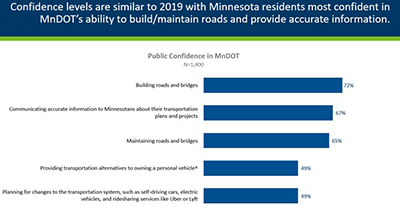
Survey results showed a generally positive outlook toward MnDOT, including high confidence levels in its projects.
|
Collecting input from customers who use Minnesota’s transportation system is an essential method for MnDOT to measure its performance and make improvements. One way the agency does this is through the omnibus survey, which is conducted every two years. The most recent omnibus survey was completed in 2022, with 1,400 Minnesotans participating, statistically representing the entire state.
Staff in the Office of Communications & Public Engagement have compiled the results, which provide agency leadership, managers and program staff with data about public perceptions of MnDOT’s core operations and performance measures. Below is a snapshot of the results related to trust in MnDOT, investing in transportation, and communication and engagement.
Generally, 7 in 10 Minnesotan’s trust MnDOT to do what is right. Overall, Minnesotans continue to be satisfied (69%) with MnDOT’s performance of their mission to plan, build, operate and maintain a safe, accessible, efficient and reliable transportation system. Additionally, public confidence in MnDOT’s ability to build roads and bridges (72%) has stabilized after a decline in 2019, while confidence in maintaining roads and bridges (65%) continues to be in line with previous waves.
Comparatively, MnDOT is exceeding in people’s trust compared to general views of state and federal governance. To put the above figures into context, according to the Pew Research Center, in 2021 only about one-quarter of Americans say they trust the government in Washington to do what is right. Further, the APM Research Lab reports that in 2021, 47% of Minnesotans trust the state government to do what is right.
Minnesotans also understand the need to invest in our transportation infrastructure. In 2021, nine in ten (90%) residents agree there is a need to invest in the transportation system. This has strengthened compared to 2019 with a significant shift from those who ‘somewhat agree’ with the need to invest more to those who ‘agree.’ Among people in outside the Twin Cities area, there is an increase in residents who believe there is a need to invest more in the transportation system after a decline in 2019.
Communicating and engaging with Minnesotans is important when making these investment decisions – and MnDOT is doing well in its communication efforts. Confidence in MnDOT’s ability to communicate accurate information (67%) has started to rebound after a decline in 2019 (64%) and one-fourth (27%) of Minnesota residents have engaged with MnDOT in the past year. Visiting a MnDOT project website or watching a video about MnDOT is how the engagement typically takes place.
“The results of MnDOT’s 2022 omnibus survey show the importance of intentional and consistent public engagement efforts,” said Jake Loesch, director of Communications and Public Engagement. “MnDOT maintains high levels of trust amongst the public we serve because the agency prioritizes being present in the community and communicating in plain and accessible language. We can all take pride in these numbers and keep challenging ourselves to do even better.”
For more information on the results, see the full report or contact Nate Lassila with any questions or to schedule a presentation. |
| |
|

|
 |
TABLE of CONTENTS
|
Intelligent Transportation Society of America honors MnDOT with two national awards |
By Doug Mack
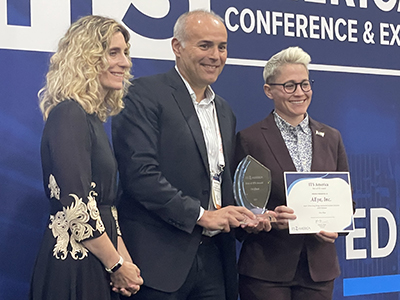
Tara Olds, Connected and Automated Vehicles director; on the right, received the first-place award, along with Laura Chase, president and CEO of ITS America; and Akram Benmbarek, vice president of Business Development and Strategic Initiatives of AEye, Inc. Olds and members of the goMARTI team also accepted the third-place award. Submitted photo |
Two MnDOT projects received Best of ITS Awards from the Intelligent Transportation Society of America at a ceremony during the organization’s annual conference on April 26. Ultra-Long Range Automated Incident Detection (AID), which MnROAD worked on with AEye and VSI Labs, won first place, and The Plum Catalyst for goMARTI won third place.
The AID project involved validating the ITS industry’s first reliable 800-meter range Automatic Incident Detection (AID) solution. This is an improvement over current systems, which have poor detection past 300m. MnDOT’s work included installing lidar sensors and cameras on I-94 to test and validate the system in any weather condition.
The Plum Catalyst project was the implementation of the goMARTI autonomous shuttle in Grand Rapids. The project is an 18-month on-demand, shared autonomous micro-transit operation working toward providing a transportation option to help improve the quality of life for differently-abled and senior citizen community members in the rural community. The operation includes five automated shuttles from May Mobility providing rides in an area of 17 square miles.
“It was an exciting evening and an honor to represent MnDOT at this conference and in accepting the awards,” said Tara Olds, director of Connected & Automated Vehicles (CAV-X). “I can’t tell you how many times people from other states and industry partners have come up to me expressing how they look to our state as a leader, want to learn more about what we are doing so we can continue to make progress together, and value our presence in the national conversations and at conferences like this.” |
| |
|

|
 |
TABLE of CONTENTS
|
Things to do before the end of the fiscal year |
By Office of Financial Management staff
MnDOT’s fiscal year is coming to a close on June 30 and Human Resources recently sent out a reminder to all agency employees regarding three important deadlines. To check your account and see if the information below applies to you, log into Employee Self-Service and select Benefits, then My Leave.
1. Did you use your Floating Holiday?
In the Leave Activity screen, select the Leave Activity By Pay Period tab. Find the Floating Holiday line. If there is a 1.00 in the Ending Balance column, then you have not taken your floating holiday yet. You must take it before June 30, 2023, or you will lose that holiday. Discuss when you would like to take it with your supervisor to get their approval.
2. Has your vacation balance dropped to 275 hours or below at least once during this fiscal year?
To learn if you have met the current fiscal year requirements:
- Select the Leave Activity by Plan tab at the top of the screen.
- Under the heading Click on Arrows to Move Between Leave Plans, select the link arrows on the right to move to Plan Type: Vacation.
- This displays your Current Year Minimum Balance. If the number is greater than 275, then you need to reduce your vacation hours by June 30, 2023.
Options to reduce your vacation balance:
- Work with your supervisor to request sufficient vacation leave to reduce your balance before June 30, 2023.
- You may donate up to 40 hours to the Vacation Donation Program (see additional information later in this issue of Newsline).
- If you are covered by the MMA contract, Commissioner's Plan or Managerial Plan, you may be eligible to convert vacation hours to deferred compensation. Please refer to your Labor Contracts and Pay Plans for more information about your eligibility.
3. Have you selected your Deferred Compensation option for FY23?
If you contribute to a deferred compensation plan, please review the FY2023 deadlines listed in MMB Deferred Compensation Deadline Memo. Please note that conversion of hours is subject to FICA and Medicare taxation.
- AFSCME and MAPE staff who contribute to deferred compensation get the match specified in their bargaining unit agreement automatically. Staff do not have the option to convert vacation leave to Deferred Compensation.
- MMA, Commissioner's and Managerial Plans staff who contribute to deferred compensation may elect the match OR convert vacation leave to deferred compensation in Self-Service. See Deferred Compensation Conversion/Match Option for instructions.
- If you currently do not participate and you want to be part of the Deferred Compensation Program, please visit the Minnesota Deferred Compensation Plan on the MSRS website.
Please contact your local payroll administrator with questions. |
 |
|

|
 |
TABLE of CONTENTS
|
Vacation Donation program helps colleagues get through tough times |
By Doug Mack
MnDOT employees help each other every day with projects and tasks that serve the state of Minnesota. Sometimes, though, we all need a bit of personal help off the job – and the Vacation Donation program is one way to assist colleagues in their time of need.
Officially called the Vacation Donation to Sick Leave Account program, this polity allows all state employees to donate up to 40 hours of accrued vacation leave each fiscal year, to be converted to sick leave that may be used by another employee who has applied to receive assistance through the program. Past beneficiaries of the program have included employees undergoing treatment for cancer or recovering from surgery complications, and parents who needed more leave to care for critically ill children.
Have you benefited from the Vacation Donation program? We’re looking for a past recipient of donated time to write a short personal account in an upcoming issue of Newsline. Previous examples can be found by looking for “vacation donation” in the Newsline archives. If you are interested in writing something or have any questions, please contact Newsline editor Doug Mack.
To learn more, visit the Vacation Donation page on the MMB website.
To donate vacation time, go to Employee Self-Service and then select Benefits > My Leave > Leave Donation. |
 |
|

|
 |
TABLE of CONTENTS
|
Global Accessibility Awareness Day offers opportunities to learn about importance of inclusion |
By Doug Mack
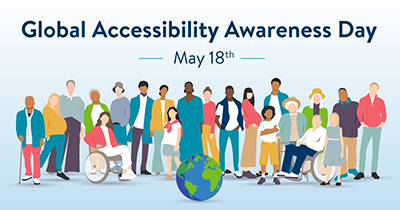
|
May 18 is Global Accessibility Awareness Day, and MNIT's Office of Accessibility is hosting events for state employees to learn about and experience the impact of inclusion and accessibility.
Panel Discussion: “Why Digital Accessibility Matters for Me and My Work”
People talk about digital accessibility, but what does it mean? How does digital accessibility or the lack of it affect people? Lived experiences of people with disabilities are the most powerful ways to learn why accessibility matters.
The panel will include a variety of individuals with disabilities. They will discuss how they navigate technology, and the difference digital accessibility makes in their work and personal lives.
This event will take place on Thursday, May 18, from 10:00 – 11:00 a.m.
Add “Real Life Perspectives” to your calendar.
Presentation: Planning an Accessible, Inclusive Meeting”
Learn how to plan and facilitate online meetings that are accessible to everyone. You’ll come away with tips and behaviors for creating and leading meetings that allow everyone to attend and fully participate. Presenters will also demonstrate useful features in Teams and WebEx.
This event will take place on Thursday, May 18, from 2:00 – 3:00 p.m.
Add “Planning an accessible, inclusive meeting” to your calendar.
The learn more about best practices for accessibility, visit the resources page of MNIT’s Office of Accessibility. |
 |
|

|
 |
TABLE of CONTENTS
|
New video offers an introduction to agency library |
By Julie Swiler, Office of Research & Innovation
As discussed in a recent issue of Newsline, the MnDOT Library has provided access to a vast network of transportation information since 1957. There are several different ways to utilize the library’s resources: visit the library on the first floor of the State Transportation Building, access library services online, or check out the new MnDOT Digital Library, a digital repository of MnDOT publications.
This new video offers a primer on the various services the library offers.
|
|
 |
|

|
 |
TABLE of CONTENTS
|
New library materials available |
By Madeline Kuncio, MnDOT Library
The latest issue of New Library Materials is available. This issue features information about the library’s new alert on Government Workforce Development. New Library Materials is a compilation of resources added to the library collection during the previous month.
Visit the library website and click “New Library Materials” to sign up. Questions and feedback are welcome at Ask a Librarian.
|
 |
|

|
 |
TABLE of CONTENTS
|
On the Job: Domingo Aguilar keeps things running in District 3B |
By Doug Mack
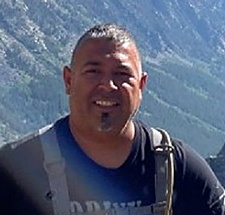
Domingo Aguilar. Submitted photo
|
Maintenance superintendent Domingo Aguilar, who works in District 3B, has been with MnDOT for more than 20 years. He also served in the Minnesota Army National Guard, including two deployments to Iraq, where he earned a Bronze Star with Valor.
How long have you been at MnDOT and in what positions?
I started as a laborer back in May of 1995, up in Crookston. I got laid off and then got back on, and then got laid off again and then came back full-time. I just worked my way up through the departments and in different positions.
What are your day-to-day tasks?
I oversee all of the roadway maintenance operations for District 3B, out of St. Cloud. I have five sub-areas and oversee all the snow and ice operations, all of the vegetation, all of the smooth pavement operations and all of the sign shop operations. It’s busy. There’s no slow season at all.
What is the most rewarding part of your job?
Being a servant to the state of Minnesota. That’s my entire life: I’ve always been a servant in one way or another, whether it’s to my family, the military, or the state of Minnesota. When I joined MnDOT, it made me happy to be out there doing something to be a part of society. I was getting compliments from friends and family: “Man, when you’re around, we know the roads are going to be good.”
Would you say it’s a good place for veterans to work?
Yes, it’s a great place for veterans, because their mindset is adapted to a tight, structured chain of command. And at MnDOT you have that. Speaking to other people I know who were in the military and now work for MnDOT, I would say we’ve been successful because we understand that structure and we know how to operate within it and how to delegate and how to take orders. When things need to get done, we get it done, and we take pride in what we do—we’re serving the state, just like we served our country.
How has your work and skillset carried over from the military to MnDOT?
I would say the big thing is leadership. I was already working at MnDOT full time when I joined the military. In the military, I was always put in situations where I had to adjust and had to step out of my box. There were there were times when I had to take the lead—that was the expectation—and I just brought that all back to MnDOT. There are times when there’s a lot going on and you just have to make a decision and go with it. I don't expect anybody to do anything I'm not going to do.
Is there anything about your job that might surprise other people?
When I talk to my friends, they think that we just plow the roads. We don't just do that. We take so many other things into consideration: planning the different chemicals to use and putting down pretreatment material. Looking at the forecast. Each storm is different. And even way before winter hits, we need to figure out what equipment we need and then get it ready.
What are your interests or hobbies outside your work with MnDOT?
I just got married in October and we have a blended family eight kids total three grandkids, so we are we're very busy. I’m part of the American Legion and the VFW and DAV [Disabled American Veterans]. I’m also on the board for the Wounded Warriors Guide Service. We set up trips throughout the United States. We have one going on right now in Arkansas and I just got back from Missouri.
Do you or a co-worker have an interesting job to share with readers? Send us your ideas, and we’ll contact you for more information.
Recent employee profiles:
|
 |
|

|
 |
TABLE of CONTENTS
|
District 8 gathers for Employee Training Day |
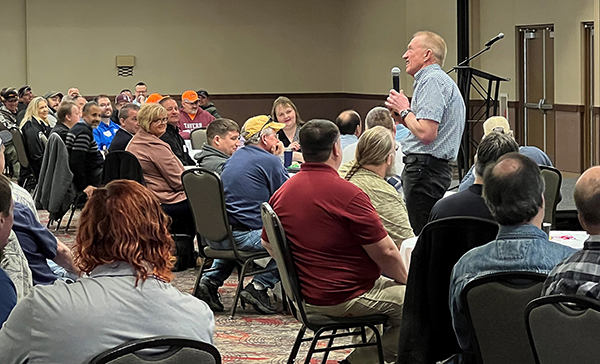
Ted Schick, Schick Corporate Learning; spoke to District 8 during their Employee Training Day May 2 in Willmar. Photo by Rich Kemp
|
|
 |
|

|
 |
TABLE of CONTENTS
|
Walk, Bike to School Day promotes safe walking, biking |
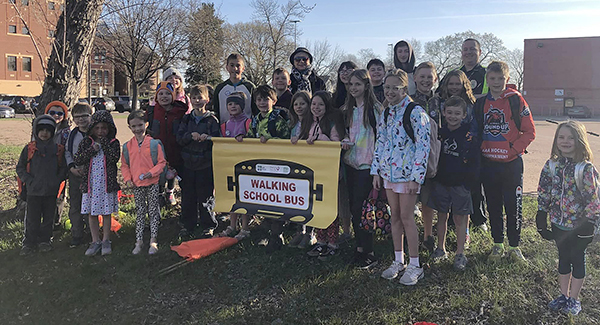
Thousands of children around the state, including this group in New Ulm, participated in Walk & Bike to School Day May 3. The event promotes safe biking and walking activities and was recognized with a proclamation by Gov. Tim Walz. Learn more at the Safe Routes to School website. Submitted photo
|
|
 |
|

|
 |
TABLE of CONTENTS
|
Message from the Commissioner: Thank you for your service to the state! |
By Commissioner Nancy Daubenberger
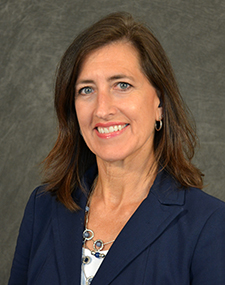
Commissioner Nancy Daubenberger |
May 7-11 is Public Service Recognition Week, as designated in an official proclamation from Gov. Walz. I’d like to take this opportunity to thank each and every MnDOT employee for their work to help the agency and the state thrive.
I speak for MnDOT’s entire leadership team when I say I appreciate everything you do in your public service for the state of Minnesota. I’m proud of your work to plan, build and maintain infrastructure that connects and supports residents and visitors—millions of people—as well as communities, businesses and the natural environment.
Our agency is a team of more than 5,000 and each of you play an important role in our collective efforts. The work you do matters!
Thank you again for your public service and everything you do for MnDOT. |
 |
|

|
 |
TABLE of CONTENTS
|
Celebrate Asian American and Pacific Islander Heritage Month with the Asian ERG |
By Chang Yang, Office of Administration

The Asian ERG’s recent events include a Lunch-and-Learn featuring author S.Z. Putnam. Pictured, from left to right: Ericca Erhard, S.Z. Putnam, Sophia Yang and Chang Yang. Photo by Shannon Fiecke |
May is Asian American and Pacific Islander Heritage Month, as designated by President George H. W. Bush more than 30 years ago. This month-long celebration provides an opportunity to honor the rich cultures, traditions and contributions of the AAPI communities in the United States. It is also a time to reflect on the diversity, achievements and resilience of these communities, while acknowledging the challenges they have faced and continue to overcome.
Asian American and Pacific Islander communities include a vast array of ethnicities, languages, religions, and traditions. It includes people whose heritage is Chinese, Filipino, Hmong, Japanese, Korean, Indian, Pakistani, Indonesian, Thai, Vietnamese, Hawaiian, Chamorro, Fijian, Samoan or Tongan, and a range of many other backgrounds. The AAPI community within the United States is astoundingly diverse.
MnDOT’s Asian Employee Resource Group serves as an employment and information resource for both internal and external community groups of AAPI origin and heritage. The ERG holds regular meetings and hosts various events. Some highlights for the past year include getting out to District 2 to race in the Bemidji Dragon Boat Festival, attending the Asian Pacific Minnesotans Leadership Awards Dinner, recruiting with Human Resources at Hmong Day at the State Fair, hosting a Lunch and Learn with S.Z. Putnam to open a dialogue about mental health awareness and participating in STEM Day at the Science Museum of Minnesota.
The Asian ERG aims to promote MnDOT’s commitment to diversity and inclusion, its status as a workplace of choice and overall civic engagement in the State of Minnesota.
For more information about this ERG or how to get involved, visit the ERG page on iHUB or contact co-chairs Chang Yang and Ericca Erhard or Frida Alvarez in the Office of Equity & Diversity. |
 |
|
|
|



